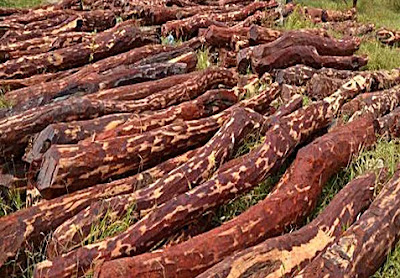Red
Sanders Tree – Erra Chandanam “Pride of Andhra Pradesh”
A Holy Tree but Discouraged
Pterocarpus
santalinus, with the common names Red Sanders, Red Sandalwood, and Saunders
wood, is a species of Pterocarpus endemic to the southern Eastern Ghats
mountain range of South India. This tree is valued for the rich red color of
its wood. The wood is not aromatic. The tree is not to be confused with the
aromatic Santalum Sandalwood trees that grow natively in South India. Red
Sander (RS) is an endangered timber tree species, endemic to southern India. It
grows in approximately 5160 km2 of fragmented forest landscape of southern
Andhra Pradesh, and in a few sporadic patches in Tamil Nadu and Karnataka
states. The wood is primarily used for making musical instruments and luxury
furniture. It also yields Santa line dye which finds use in coloring foodstuff
and pharmaceutical Preparations.
- Native of India, grows only in India
- Valued similar to Sandal wood
- Medicinally, Scientifically, Ornamentally very Important & Essential Tree
- Best tree to grow in increasing temp, Climate Change in degraded dry lands (60% of India)
- Traditional Tirupachi toys were made of it
- Used in traditional Ayurvedic, Sidha medicines
- Believed that it provides wealth, of course
In
Hinduism, this wood has been traditionally used as a sacred wood. The priests
and higher class castes such as Brahmin extensively use this wood on many of
their rituals. Sandalwood paste is integral to rituals and ceremonies, to mark
religious utensils and to decorate the icons of the deities. It is also
distributed to devotees, who apply it to the forehead or the neck and chest.
Preparation of the paste is a duty fit only for the pure, and is therefore
entrusted in temples and during ceremonies only to priests.
The
paste is prepared by grinding wood by hand upon granite slabs, which is mixed
with saffron or other such pigments to make Chandan. Chandan further mixed with
herbs, perfumes, pigments and some other compounds result in Javadhu. Kalabham,
Chandan and Javadhu are dried and used as Kalabham powder.
Chandan
powder and Javadhu powder respectively. Chandan powder is very popular in North
India and is also used in Nepal. In Tirupati after religious tonsure, Sandal
paste is applied to protect the skin. Sandalwood is considered in Hinduism and
Ayurveda to bring one closer to the divine. Thus Sandal is one of the most used
holy elements in the Hindu and Vedic society. Sandalwood, along with agar wood,
is the most commonly used incense material by the Chinese and Japanese in
worship and various ceremonies. Chinese people believed red sandalwood
furniture is lucky at home.
Since
last one decade most of the degraded areas have been rescrubbed with the
implementation of Community forest management programme through more than 7100
Vana Samrakshana Samithis. Red Sanders (pride of Andhra Pradesh) is growing in
the Cuddapah and Chittoor in large extents and in limited extent in the Nellore
District. This species of wood is found, only in the A.P. State.
MEDICINAL
VALUE
The
wood at the center of the trunk (heartwood) is used as medicine. Red sandalwood
is used for treating digestive tract problems, fluid retention, and coughs and
for “blood purification.” Red sandalwood might increase the loss of body water
through the urine (diuretic effect). It might also have drying effects that may
help reduce diarrhea and break up mucus to make it easier to cough up.
It
is used in diseases like cough, vomiting, fever, hyperdipsia, helminthiasis,
diseases of the blood and eye, wounds etc. The heartwood and fruits of Rakta
chandana have great medicinal value. It reduces the burning sensation, arrests
bleeding, alleviates edema and ameliorates various skin disorders, hence, is an
effective external application as a paste, in burning sensation, headache,
dermatomes and ophthalcopathies. It‟s been extensively used in Ayurveda to
treat fever, digestive problem, treating high blood pressure and lowering the Sugar
level of diabetic patients.
IN
FOLKLORE / TRIBAL MEDICINE
The
heartwood has various uses in traditional medicines and is popular for the
treatment of diabetes apart
from other ailments. The wood paste is applied externally specially for healing
various skin diseases and blemishes. Yerukula and Irula tribes of Chittoor
district in Andhra Pradesh use whole plant of P. santalinus for ulcer
treatment.
For treating acute jaundice, about one hundred grams of powdered
stem bark is boiled in 500 ml of water for 3-4 hours till the volume is reduced
to half the original content. The solution is cooled and then ten grams of
jaggery is added and made into pills, two to three pills is administered every
day for ten days.
Malamalasar tribe of Perambikulam wildlife sanctuary in
Kerala considers wood paste as a blood purifier, for curing skin diseases and
poisonous affections. Various tribes in coastal Karnataka use Red Sanders as an
anti inflammatory for the treatment of Herpes.
Also
known as Rakta Chandana Powder/ Pterocarpus santalinus is a variety of
sandalwood powder. It is dark maroon in color and doesn’t have any fragrance to
it. It is different from sandalwood powder.

